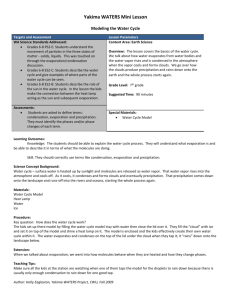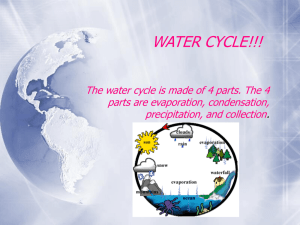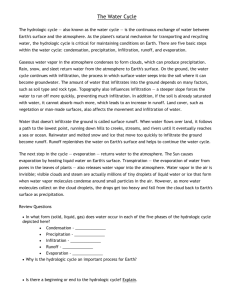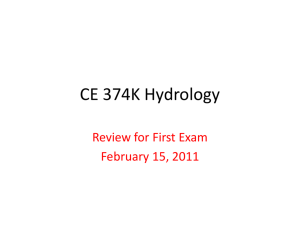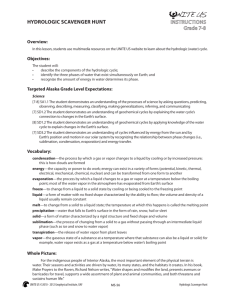Water Cycle
advertisement
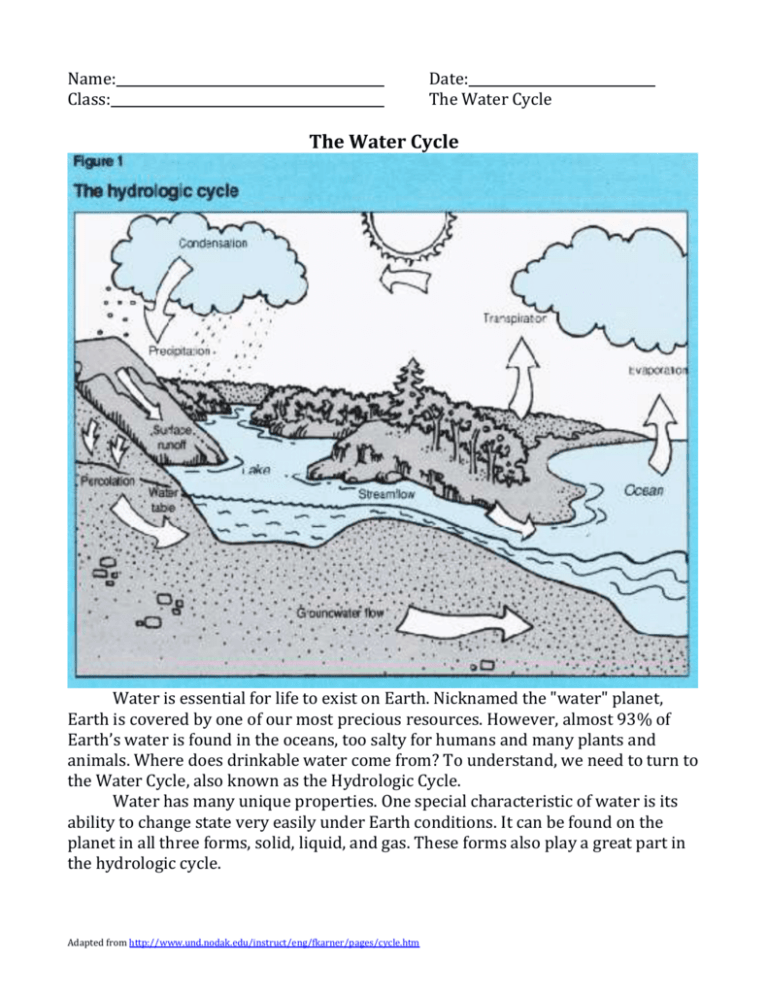
Name: Class: Date: The Water Cycle The Water Cycle Water is essential for life to exist on Earth. Nicknamed the "water" planet, Earth is covered by one of our most precious resources. However, almost 93% of Earth’s water is found in the oceans, too salty for humans and many plants and animals. Where does drinkable water come from? To understand, we need to turn to the Water Cycle, also known as the Hydrologic Cycle. Water has many unique properties. One special characteristic of water is its ability to change state very easily under Earth conditions. It can be found on the planet in all three forms, solid, liquid, and gas. These forms also play a great part in the hydrologic cycle. Adapted from http://www.und.nodak.edu/instruct/eng/fkarner/pages/cycle.htm Exactly what is the hydrologic cycle? The hydrologic cycle takes place in the hydrosphere, the region containing all the water in the atmosphere and on the surface of the earth. The cycle is the movement of water through this hydrosphere. The process begins with condensation, when water vapor condenses in the atmosphere to form clouds. Condensation occurs when the temperature of the air or earth changes. Water changes states when temperatures fluctuate. So when the air cools enough, water vapor has to condense on particles in the air to form clouds. The drops of dew found on plants in the morning is an example of condensation. As clouds form, winds move them across the globe. When the clouds can't hold the moisture anymore, they release it in the form of precipitation, which can be snow, rain, hail, etc. The next three stages, infiltration, runoff, and evaporation, occur at Earth’s surface. Infiltration occurs when precipitation flows into the ground. This depends a lot on how permeable the ground is. Loose soil that lets water flow into it easily is more permeable, while tightly packed soil or rock that blocks the flow of water is less permeable. When water infiltrates the ground, it is called groundwater. If precipitation occurs faster than the water can infiltrate the ground, it becomes runoff. Runoff remains on the surface and flows into streams, rivers, and eventually large bodies such as lakes or the ocean. Groundwater also moves through soil and rock into rivers, lakes, and the ocean. As both of these processes are happening, the power of the sun is driving this cycle by causing evaporation. Evaporation is the change of liquid water to a gas, water vapor. Sunlight helps this process by increasing the temperature of liquid water in oceans and lakes. As the liquid heats, molecules get excited and bounce into the atmosphere, forming a gas. Warm air containing water vapor rises up into the atmosphere, starting the cycle again. Considering so little of the water on earth is drinkable to people, it is amazing the supply has survived as long as it has. The hydrologic cycle continues to move water and keep sources fresh. It is estimated that 100 million billion gallons a year cycle through this process. Without the water cycle, life would not be possible on Earth. We need it to sustain us and for all of our life processes to function. Answer the questions below using the article to help you. To get full credit, you must code the text for sections C and D. A. Diagram. Use the diagram to predict the meaning of the word. 1. What do you think transpiration means? Why do you think this? Adapted from http://www.und.nodak.edu/instruct/eng/fkarner/pages/cycle.htm B. Vocabulary. Match each word to its definition. 1. Precipitation 2. Evaporation 3. Condensation 4. Runoff 5. Infiltration 6. Groundwater A. Water vapor cooling & changing to liquid water. B. Water found in soil or rock. C. Water falling from clouds as rain, snow, etc. D. Liquid water changing to a gas, water vapor. E. Water flowing into spaces in the soil or rock. F. Water flowing across earth’s surface to the ocean. C. Vocabulary. Draw a box around the word and underline clues in the text that helped you answer the question. Write your prediction in the margin. Then, choose the best definition. 7. “Fluctuate” probably means… A. measure C. decrease B. change D. stay the same 8. “Permeable” most nearly means… A. open and porous (full of holes) B. solid and closed off C. able to flow D. forever 9. “Sustain” probably means… A. damage C. B. D. support D. Use details from the text to answer each question. Label the question “text” or “text-think.” Underline important details in the question. Mark the question number in the margin near the sections that helped you answer it. 10. What does the author mean by the statement “the power of the sun is driving this cycle?” 11. Describe at least three things that would change on Earth if the water cycle stopped. Adapted from http://www.und.nodak.edu/instruct/eng/fkarner/pages/cycle.htm


